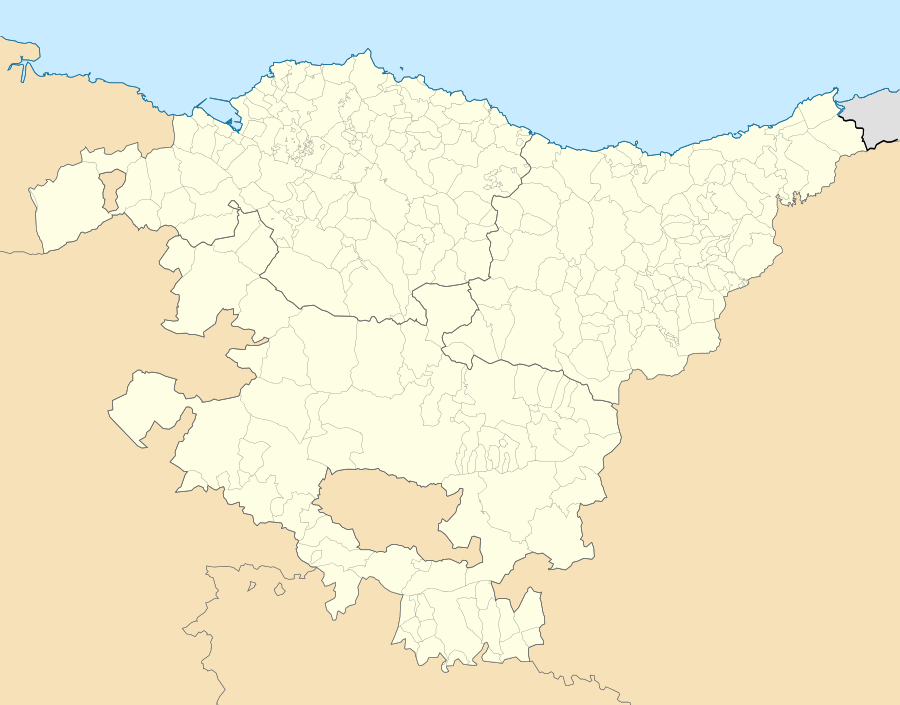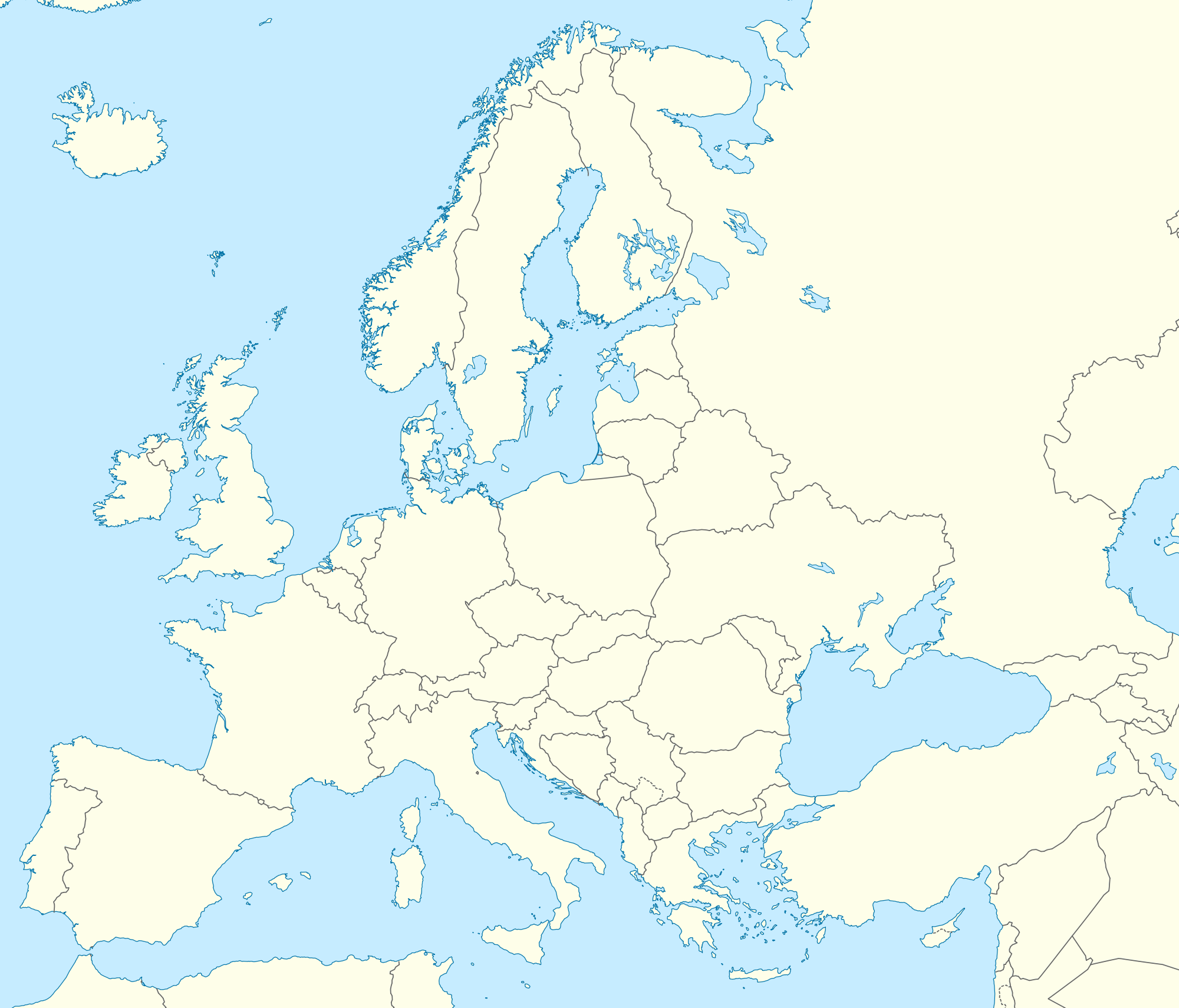Bilbao Airport
| Bilbao Airport Bilboko aireportua (eu) Aeropuerto de Bilbao (es) | |||||||||||||||
|---|---|---|---|---|---|---|---|---|---|---|---|---|---|---|---|
_(BIO_-_LEBB)_AN0466068.jpg) | |||||||||||||||
 BIO | |||||||||||||||
| Summary | |||||||||||||||
| Airport type | Public | ||||||||||||||
| Owner/Operator | Aena | ||||||||||||||
| Location | Bilbao, Spain | ||||||||||||||
| Hub for | Vueling | ||||||||||||||
| Built | 1928 | ||||||||||||||
| Elevation AMSL | 42 m / 137 ft | ||||||||||||||
| Coordinates | 43°18′04″N 002°54′38″W / 43.30111°N 2.91056°WCoordinates: 43°18′04″N 002°54′38″W / 43.30111°N 2.91056°W | ||||||||||||||
| Website | aena-aeropuertos.es | ||||||||||||||
| Runways | |||||||||||||||
| |||||||||||||||
| Statistics (2014) | |||||||||||||||
| |||||||||||||||
Bilbao Airport (IATA: BIO, ICAO: LEBB) is a public airport located 9 km (5.6 mi) north[2] of Bilbao, in the municipality of Loiu, in Biscay. It is the most important airport in the Basque Country and northern Spain, with 4,045,613 passengers in 2011. It is famous for its new main terminal opened in 2000 designed by Santiago Calatrava. It is the 2nd most important base for Vueling, with the second highest number of destinations offered.
History
After various aeronautic experiments in the province of Biscay, in October 1927 steps were taken by the Union of Public Works to establish an airport in Bilbao. A Provincial Board was created to study the possible location of the airport. It was not until 1936 that the General Aeronautics Management authorised the installation of an airport in Sondika. However, due to the site's many deficiencies, the airport was not considered of interest. Bilbao is surrounded by mountains and a flat valley without significant population had to be found.
The construction works commenced during the Civil War but during this time and until June 1937 the airport was only used as a base for military activities. In 1938, the second stage of the airport's development began. The council resumed procedures with the government to modify the primitive project of 1936 and the drafting of a new project was authorised and later approved by the General Management of Infrastructure.
In 1940, it was decided by common agreement with the local organisations affected to build a civilian airport in Sondika. The construction works progressed slowly and on 19 September 1948, the airport was at last opened to daytime traffic with the establishment of an air path to Madrid by Aviación y Comercio, SA. Two years later, the terminal, named Carlos Haya after the well-known pilot from Bilbao, began to give service. At this time, the airport had an asphalt runway, the 11/29 (measuring 1,440 by 45 m (4,724 by 148 ft)), another earth runway (measuring 1,500 by 150 m (4,921 by 492 ft)), a taxiway, a passenger terminal, a tower control, a radio beacon, a direction finder as well as police, post office, weather, health, fuel and telephone services. In 1955, a taxiway was built to link the runway with the parking stands and terminal. An apron measuring 124 by 60 m (407 by 197 ft), a hangar for the Royal Flying Club of Vizcaya and permanent facilities for Campsa were also built.
Between 1964 and 1965, an instrumental ILS landing system and a meteorological radio for storm detection were installed; the runway was extended to 2,000 m (6,562 ft) and the apron to 12,000 m2 (130,000 sq ft). In 1975, the runway was surfaced and its orientation became 10/28 due to the change in magnetic declination. In 1977, the parking stand was extended, a link road was built and an ILS system was instaled. The runway 12/30, measuring 2,600 m (8,530 ft) long, was opened the same year and the airport was classified as first category the following year. As a result of the population density of the area, approaching planes may have to fly over the extensive Derio cemetery.
During the eighties, the ILS landing system entered into service for runway 10/28; the communication centre, passenger terminal and parking facilities were enlarged; and a fire service building and cargo terminal were constructed.
On 19 February 1985, an Iberia flight from Madrid crashed into Mount Oiz, all passengers and crew died.
In 1996, a new taxiway with two rapid exits and a new aircraft parking apron were built. The works required the removal of tons of soil poisoned with lindane residues. In May 1999, the new tower control was put into service, which allowed for a more centred vision of the airfield and at the same time facilitated airport operations. On 19 November 2000, a new terminal area was opened in the north zone, consisting of a new terminal building, with a surface area of 32,000 m2 (340,000 sq ft), a car park with 3,000 parking spaces measuring 95,000 m2 (1,020,000 sq ft) and a north apron for aircraft parking to serve the new terminal area.
In February 2009 plans were announced to expand the terminal building, the facilities and the car parking so as to double the current capacity to 8 million passengers. The work will be finished in 2014 and cost €114 million.
Design of the passenger terminal

The terminal has a sleek design, with two symmetrical "wings" and a sharp tip at its center which is specially visible when approaching the terminal from the sides. This original design has granted the building the nickname of "La Paloma" ("The Dove").[3] White concrete and glass have been used. The interiors are open and luminous spaces, distributed in two floors, the upper one for departures (check-in counters and gates) and the lower for arrivals.
There has been some criticism of Santiago Calatrava's design by Aena, the Spanish airport authority, because it seems difficult to make further enlargements in the terminal's capacity because the design is too closed. In spite of this, modifications took place in 2005-2006 in the check-in area to provide enhanced shopping facilities for travellers, which almost doubled the retail space now being offered.
Users of the airport widely complained about its lack of an arrivals area, since once passengers cleared customs, they stepped directly outside, and there they were often exposed to the elements. The airport built a glass-walled shelter to remedy this problem.[3]
Traffic
The airport has seen a constant increase in its traffic numbers, the old terminal was already saturated and obsolete in 1990, although it had been renewed only a few years earlier. At the present day Bilbao is the most important hub in northern Spain and the number of passengers using the new terminal continues to rise, especially after the increased tourist interest in the city since the opening of the Guggenheim museum.
With the past increase of traffic, the terminal would have become saturated again in a year because it is designed to handle about 4.5 million passengers per year, in 2007 it went nearly to its maximum capacity. However, the global financial crisis of 2008 has reversed the situation as of early 2009, decreasing the number of passengers by 24% in January compared to previous year. In 2014 traffic is on the rise again and will see the recovery of the 4 million passenger mark.[4]
Airlines and destinations
Destinations Map
The map includes destionations in Europe served from Bilbao Airport.


Maps Legend:
![]() All-year-long destination
All-year-long destination![]() Seasonal destination
Seasonal destination ![]() New destination
New destination
Statistics
 |
| Updated: 15 January 2015.[1] 2014 data provisional. |
| Passengers | Change from previous year | Aircraft movements | Cargo (tonnes) | |
|---|---|---|---|---|
| 2000 | 2,556,373 | | 45,506 | 4,038 |
| 2001 | 2,491,770 | | 44,166 | 3,674 |
| 2002 | 2,463,698 | | 39,832 | 3,699 |
| 2003 | 2,850,524 | | 44,009 | 3,813 |
| 2004 | 3.395,773 | | 50,361 | 4,152 |
| 2005 | 3,843,953 | | 56,285 | 3,956 |
| 2006 | 3,876,072 | | 58,574 | 3,417 |
| 2007 | 4,286,751 | | 63,076 | 3,230 |
| 2008 | 4,172,903 | | 61,682 | 3,178 |
| 2009 | 3,654,957 | | 54,148 | 2,691 |
| 2010 | 3,888,969 | | 54,119 | 2,547 |
| 2011 | 4,045,613 | | 54,432 | 2,633 |
| 2012 | 4,171,092 | | 50,030 | 2,663 |
| 2013 | 3,800,789 | | 42,683 | 2,536 |
| 2014 | 4,015,352 | | 42,590 | 2,855 |
| Source: Aena Statistics[1] | ||||
Top Carriers
| Rank | Carrier | Passengers 2013 | % | Passenger % Change 2012 |
|---|---|---|---|---|
| 1 | | 1,327,209 | 34.92 | |
| 2 | | 478,850 | 12.60 | |
| 3 | | 431,121 | 11.34 | |
| 4 | | 406,740 | 10.70 | |
| 5 | | 222,377 | 5.85 | |
| 6 | | 177,421 | 4.67 | |
| 7 | | 171,781 | 4.52 | |
| 8 | | 104,830 | 2.76 | |
| 9 | | 92,445 | 2.43 | |
| 10 | | 85,314 | 2.24 | |
| Source: Aena Statistics[1] | ||||
Busiest routes
| Rank | City | Passengers 2013 | % | Passenger % Change 2012 |
|---|---|---|---|---|
| 1 | |
606,514 | 15.96 | |
| 2 | |
508,759 | 13.39 | |
| 3 | |
222,529 | 5.85 | |
| 4 | |
209,876 | 5.52 | |
| 5 | |
171,781 | 4.52 | |
| 6 | |
164,042 | 4.32 | |
| 7 | |
163,498 | 4.31 | |
| 8 | |
153,188 | 4.03 | |
| 9 | |
142,661 | 3.75 | |
| 10 | |
130,744 | 3.44 | |
| Source: Aena Statistics[1] | ||||
Public transport
- BizkaiBus: a bus line (3247) connects Bilbao center (Moyúa square) and the city bus station with the airport.
- Lurraldebus: A bus operated by PESA to Donostia-San Sebastián It's only stop is at Zarautz - adjacent to one of the town's two Euskotren stations (at the eastern end of the town). A bus operated by PESA to Mondragón with stops in Eibar and Bergara. the last daily service continues until Oñati.
- Rail transport: It is planned to build a train connection between City Centre and the Airport. ω
Incidents & accidents
- On 19 February 1985, Iberia Flight IB610 from Madrid crashed into Mount Oiz. All 148 passengers and crew on board were killed.
See also
References
- ↑ 1.0 1.1 1.2 1.3 1.4 AENA passenger statistics and aircraft movements
- ↑ 2.0 2.1 Spanish AIP (AENA)
- ↑ 3.0 3.1 Daley, Suzanne (13 September 2013). "A Star Architect Leaves Some Clients Fuming". The New York Times. Retrieved 13 September 2013.
- ↑ http://www.elcorreodigital.com/vizcaya/20090219/vizcaya/paloma-pierde-pasajeros-primer-20090219.html
- ↑ "CSA Czech Airlines Continues Europe Expansion in S15". Airline Route. Retrieved 24 November 2015. Check date values in:
|accessdate=(help) - ↑ "easyJet adds 20 new routes for summer 2015". easyJet. 10 December 2014.
External links
![]() Media related to Bilbao Airport at Wikimedia Commons
Media related to Bilbao Airport at Wikimedia Commons
- Official website (English) (Spanish)
| ||||||||||||||||||